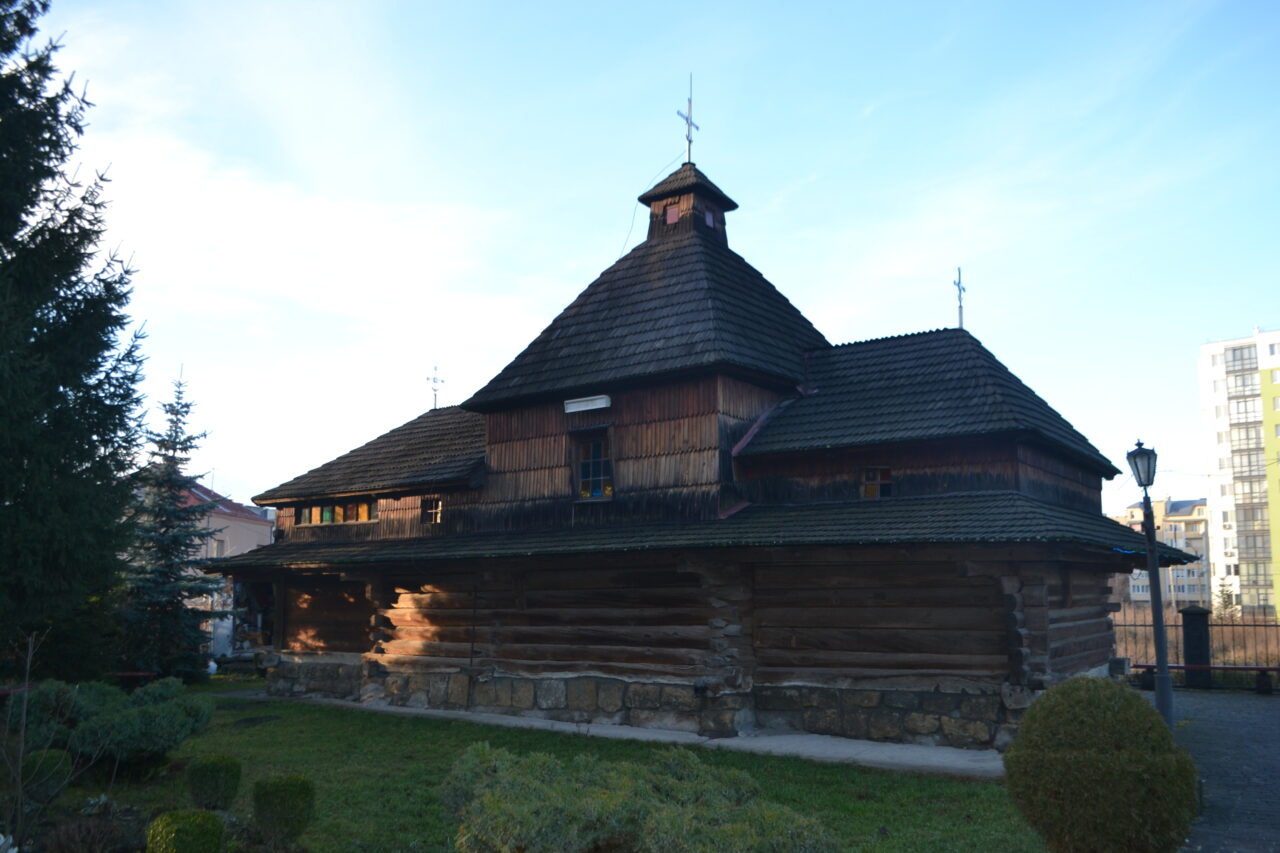All modern large cities, like construction sets for children, are assembled from the center and countless villages that once surrounded the city. Only later they got so attached to it as not to be easily torn away. Well, we don’t tear them away — but get them urbanized and built up instead. The residents of city suburbs are often unaware that they live in a place where a completely different settlement stood a century ago. The memory of the past remains brighter if that past has left remembrances of itself in the form of architectural monuments in the now-urban neighborhoods.
Sykhiv, which is referred in so many anecdotes, jokes and curses as the farthest edge of the Lviv ecumene, has just such a monument. However, not everyone among Sykhiv’s locals has heard of it; it takes some time to find it among all the railways, garages, skyscrapers and private residences of the neighborhood. We might as well suggest the exact address: Sadybna St. 1-A, at the intersection with Maidanna Street.
The squat, low, three-nave, one-domed Trinity Church of Galician (Opole) type is popularly known as “the Cossack Church” and, according to historians, dates back to the year 1600, which for a monument of wooden architecture is an unsually old age. This date has been discovered in the Krakow archival documents. Such a round number should have pleased local historians, but it actually shattered the old legend that the oak church on the far outskirts of Lviv was allegedly ordered to be built by Hetman Bohdan Khmelnytsky himself, when he besieged Lviv — not for the first time at that — in 1654.
The basis for the legend was an inscription inside the church: “This temple of God was built by the Cossacks shortly after Bohdan the Great’s siege of Lviv, restored in the year of God 1932, and the chancel along with the gynecium were repainted in the year of God 1933 in the times of the national calamity due to the efforts of Fr. Theophilus Hornykevych and the parishioners of Sykhiv. For the second time, this temple was repaired in 1954 with the help of the Archbishop of Lviv Kir-Pankratii, through the efforts of the Abbot Protoiereus M. Tarnavskyi and parishioners.”
The inscription was written exactly 300 years after the Cossack siege of Lviv and, it appears, was inspired not by academic research, but exclusively by folktales. The temple at the time of writing was closed for worship: the Trinity Church got closed after World War II. The restoration of the old inoperative building was initiated exclusively by the clergy, the priests. But a more thorough restoration took place in 1971, when it was done by Lviv restoration specialists. They restored it and left it behind afterwards. The temple, deprived of any useful purpose, was getting dilapidated. Some 20 years later, it looked run-down and derelict. The church rose from oblivion in 2007-2009, when facade repairs took place. At the time, the wood was treated with firestop and anti-corrosion mortar.
During the renovation in 1932, a unique tiny bell tower over the gynecium was dismantled. That’s too bad, because both the bell tower and the temple itself survived the Polish-Ukrainian War of 1918-1919, when most of the houses in the area were destroyed.
Now nothing reminds you of the times of decline: the churchyard is planted with flowers and lilacs. During warm seasons, it’s very cozy here. Among the lush greenery, the tiny Galician church (only 11.74 by 4.58 m) covered with wood shingles looks quite organic: its peers in Lviv can only be found in the open-air museum, while the Sykhiv beauty remains free, it never changed its location — and is not going to. In fact, back in the 1980s, it was planned to move it to the open-air museum. But then the artistic treasure inside the temple — we’ll discuss that later — prevented it from happening.
The windows in the Opole-style tiny church are small, and the hipped tent-like roof is, too, modestly sized. And if you wanted to attend the church service (the temple is used by one of the Greek Catholic communities in Lviv) or just inspect the interior, you’d have to bow low at the shrine. In more than 400 years of existence, it has plunged deep into the ground, so the north door here is very low — only one and a half meters.
The interior is worth your bow though. Slightly inward sloping, the nave walls of the temple are covered in murals from 1683(!); depicted among the floral ornaments are Saints Demetrius of Thessaloniki, George of Lydda and Theodore of Amasea. Above are scenes from the Old Testament: Jonah getting out of a whale’s belly, Abraham with his family and the image of the Trinity. Even higher is the Passions of Christ. Due to the fact that the murals are created in different styles, there is a hypothesis that a certain part of the wall painting was made even before 1683. One of the authors could have been a well-known Lviv iconographer Oleksandr Lianytskyi. The other might be a self-taught artist whose drawing techniques were worse. The icon of St. Joseph and the Christ Child, located on the right wall of the church, was presented to the temple in 1783. On raising your head, you’ll see that the dome is decorated with the image of Christ Pantocrator. Since 1994, the wall painting has been restored by the specialists of a state-owned restoration enterprise.
A small cemetery near the church houses the grave of Blessed Andrii Ishchak, the priest of the Trinity Church in 1928-1941. The priest, who was killed by the NKVD, was proclaimed martyr by Pope John Paul II when he was speaking to the public in Sykhiv in 2001.










